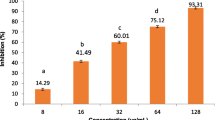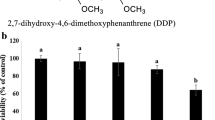Abstract
Short-chain and medium-chain aldehydes and their derivatives, yielded by the enzymes hydroperoxide lyases from fatty acids, are present in many products of plant origin. They are often used as supplements to food to postpone its expiration date and to add a flavor of freshness. Since these compounds can be absorbed by the intestine cells and pass into systemic circulation, it is important to be aware of their influence on human health. In the present study, the potential biological activity of aldehydes and alcohols with chains containing six to nine carbon atoms were assessed. Their proinflammatory activities were tested in the experimental system based on donors’ whole blood. It was found that nine-carbon oxylipins stimulated the synthesis of the proinflammatory TNF-α cytokine (tumor necrosis factor alpha), and the stimulation by the aldehydes was weaker than that caused by the alcohols. The oxylipins containing six or eight carbons did not manifest proinflammatory activity. The obtained data may be of help to work out nutritional recommendations for patients suffering from inflammatory diseases.


Similar content being viewed by others
REFERENCES
Liavonchanka, A. and Feussner, I., Lipoxygenases: occurrence, functions and catalysis, J. Plant Physiol., 2006, vol. 163, p. 348. https://doi.org/10.1016/j.jplph.2005.11.006
Andreou, A. and Feussner, I., Lipoxygenases - structure and reaction mechanism, Phytochem., 2009, vol. 70, p. 1504. https://doi.org/10.1016/j.phytochem.2009.05.008
Brash, A.R., Ingram, C.D., and Harris, T.M., Analysis of a specific oxygenation reaction of soybean lipoxygenase-1 with fatty acids esterified in phospholipids, Biochem., 1987, vol. 26, p. 5465. https://doi.org/10.1021/bi00391a038
Leon, J., Royo, J., Vancanneyt, G., Sanz, C., Silkowski, H., Griffiths, G., and Sanchez-Serrano, J.J., Lipoxygenase H1 gene silencing reveals a specific role in supplying fatty acid hydroperoxides for aliphatic aldehyde production, J. Biol. Chem., 2002, vol. 277, p. 416. https://doi.org/10.1074/jbc.M107763200
Nakashima, A., von Reuss, S.H., Tasaka, H., Nomura, M., Mochizuki, S., Iijima, Y., Aoki, K., Shibata, D., Boland, W., Takabayashi, J., and Matsui, K., Traumatin- and Dinortraumatin-containing Galactolipids in Arabidopsis: their formation in tissue-disrupted leaves as counterparts of green leaf volatiles, J. Biol. Chem., 2013, vol. 288, p. 26078. https://doi.org/10.1074/jbc.M113.487959
Lee, D.S., Nioche, P., Hamberg, M., and Raman, C.S., Structural insights into the evolutionary paths of oxylipin biosynthetic enzymes, Nature, 2008, vol. 455, p. 363. https://doi.org/10.1038/nature07307
Grechkin, A.N. and Hamberg, M., The “heterolytic hydroperoxide lyase” is an isomerase producing a short-lived fatty acid hemiacetal, Biochim. Biophys. Acta, 2004, vol. 1636, p. 47. https://doi.org/10.1016/j.bbalip.2003.12.003
Matsui, K., Kurishita, S., Hisamitsu, A., and Kajiwara, T., A lipid-hydrolysing activity involved in hexenal formation, Biochem. Soc. Trans., 2000, vol. 28, p. 857.
Zimmerman, D.C. and Coudron, C.A., Identification of traumatin, a wound hormone, as 12-oxo-trans-10-dodecenoic acid, Plant Physiol., 1979, vol. 63, p. 536. https://doi.org/10.1104/pp.63.3.536
Kallenbach, M., Gilardoni, P.A., Allmann, S., Baldwin, I.T., and Bonaventure, G., C12 derivatives of the hydroperoxide lyase pathway are produced by product recycling through lipoxygenase-2 in Nicotiana attenuata leaves, New Phytol., 2011, vol. 191, p. 1054. https://doi.org/10.1111/j.1469-8137.2011.03767.x
Stumpe, M., Bode, J., Göbel, C., Wichard, T., Schaaf, A., Frank, W., Frank, M., Reski, R., Pohnert, G., and Feussner, I., Biosynthesis of C9-aldehydes in the moss Physcomitrella patens, Biochim. Biophys. Acta, 2006, vol. 1761, p. 301. https://doi.org/10.1016/j.bbalip.2006.03.008
Tijet, N., Schneider, C., Muller, B.L., and Brash, A.R., Biogenesis of volatile aldehydes from fatty acid hydroperoxides: molecular cloning of a hydroperoxide lyase (CYP74C) with specificity for both the 9- and 13-hydroperoxides of linoleic and linolenic acids, Arch Biochem Biophys., 2001, vol. 386, p. 281. https://doi.org/10.1006/abbi.2000.2218
Noordermeer, M.A., Veldink, G.A., and Vliegenthart, J.F.G., Alfalfa contains substantial 9-hydroperoxide lyase activity and a 3Z:2E-enal isomerase, FEBS lett., 1999, vol. 443, p. 201. https://doi.org/10.1016/S0014-5793(98)01706-2
Kunishima, M., Yamauchi, Y., Mizutani, M., Kuse, M., Takikawa, H., and Sugimoto, Y., Identification of (Z)-3:(E)-2-hexenal isomerases essential to the production of the leaf aldehyde in plants, J. Biol. Chem., 2016, vol. 291, p. 14023. https://doi.org/10.1074/jbc.M116.726687
Bate, N.J., Riley, J.C.M., Thompson, J.E., and Rothstein, S.J., Quantitative and qualitative differences in C6-volatile production from the lipoxygenase pathway in an alcohol dehydrogenase mutant of Arabidopsis thaliana, Physiol. Plant., 1998, vol. 104, p. 97. https://doi.org/10.1034/j.1399-3054.1998.1040113.x
Tanaka, T., Ikeda, A., Shiojiri, K., Ozawa, R., Shiki, K., Nagai-Kunihiro, N., Fujita, K., Sugimoto, K., Yamato, K.T., Dohra, H., Ohnishi, T., Koeduka, T., and Matsui, K., Identification of a hexenal reductase that modulates the composition of green leaf volatiles, Plant Physiol., 2018, vol. 178, p. 552. https://doi.org/10.1104/pp.18.00632
D'Auria, J.C., Pichersky, E., Schaub, A., Hansel, A., and Gershenzon, J., Characterization of a BAHD acyltransferase responsible for producing the green leaf volatile (Z)-3-hexen-1-yl acetate in Arabidopsis thaliana, Plant J., 2007, vol. 49, p. 194. https://doi.org/10.1111/j.1365-313X.2006.02946.x
Kihara, H., Tanaka, M., Yamato, K.T., Horibata, A., Yamada, A., Kita, S., Ishizaki, K., Kajikawa, M., Fukuzawa, H., Kohchi, T., Akakabe, Y., and Matsui, K., Arachidonic acid-dependent carbon-eight volatile synthesis from wounded liverwort (Marchantia polymorpha), Phytochem., 2014, vol. 107, p. 42. https://doi.org/10.1016/j.phytochem.2014.08.008
Noordermeer, M.A., Van Dijken, A.J., Smeekens, S.C., Veldink, G.A., and Vliegenthart, J.F., Characterization of three cloned and expressed 13-hydroperoxide lyase isoenzymes from alfalfa with unusual N-terminal sequences and different enzyme kinetics, Eur. J. Biochem., 2000, vol. 267, p. 2473. https://doi.org/10.1046/j.1432-1327.2000.01283.x
Matsui, K., Minami, A., Hornung, E., Shibata, H., Kishimoto, K., Ahnert, V., Kindl, H., Kajiwara, T., and Feussner, I., Biosynthesis of fatty acid derived aldehydes is induced upon mechanical wounding and its products show fungicidal activities in cucumber, Phytochem., 2006, vol. 67, p. 649. https://doi.org/10.1016/j.phytochem.2006.01.006
Prost, I., Dhondt, S., Rothe, G., Vicente, J., Rodriguez, M.J., Kift, N., Carbonne, F., Griffiths, G., Esquerré-Tugayé, M.-Th., Rosahl, S., Castresana, C., Hamberg, M., and Fournier, J., Evaluation of the antimicrobial activities of plant oxylipins supports their involvement in defense against pathogens, Plant Physiol., 2005, vol. 139, p. 1902. https://doi.org/10.1104/pp.105.066274
Matsui, K., Green leaf volatiles: hydroperoxide lyase pathway of oxylipin metabolism, Curr. Opin. Plant Biol., 2006, vol. 9, p. 274. https://doi.org/10.1016/j.pbi.2006.03.002
Savchenko, T., Pearse, I.S., Ignatia, L., Karban, R., and Dehesh, K., Insect herbivores selectively suppress the HPL branch of the oxylipin pathway in host plants, Plant J., 2013, vol. 73, p. 653. https://doi.org/10.1111/tpj.12064
Loreto, F., Barta, C., Brilli, F., and Nogues, I., On the induction of volatile organic compound emissions by plants as consequence of wounding or fluctuations of light and temperature, Plant Cell Environ., 2006, vol. 29, p. 1820. https://doi.org/10.1111/j.1365-3040.2006.01561.x
Shipelin, V.A. and Sidorova, Yu.S., Oxylipins - biologically active substances in food, Vopr. pit., 2020, vol. 89, p.16 https://doi.org/10.24411/0042-8833-2020-10073
Thies, F., Miles, E.A., Nebe-von-Caron, G., Powell, J.R., Hurst, T.L., Newsholme, E.A., and Calder, P.C., Influence of dietary supplementation with long-chain n-3 or n-6 polyunsaturated fatty acids on blood inflammatory cell populations and functions and on plasma soluble adhesion molecules in healthy adults, Lipids, 2001, vol. 36, p. 1183. https://doi.org/10.1007/s11745-001-0831-4
Radzyukevich, Y.V., Kosyakova, N.I., and Prokhorenko, I.R., Synergistic effect of Dermatophagoides pteronyssinus allergen and Escherichia coli lipopolysaccharide on human blood cells, PloS One, 2018, vol. 13, p. e0207311.https://doi.org/10.1371/journal.pone.0207311
Barret, R., Medicinal Chemistry: fundamentals, Elsevier, 2018.
Veber, D.F., Johnson, S.R., Cheng, H.-Y., Smith, B.R., Ward, K.W., and Kopple, K.D., Molecular properties that influence the oral bioavailability of drug candidates, J. Med. Chem., 2002, vol. 45, p. 2615. https://doi.org/10.1021/jm020017n
Filimonov, D.A., Lagunin, A.A., Gloriozova, T.A., Rudik, A.V., Druzhilovsky, D.S., Pogodin, P.V., and Poroiko, V.V., Prediction of biological activity spectra of organic compounds using a web resource PASS ONLINE, Khim. geterots. soed., 2014, vol. 3, p. 483.
Kumar, A., Taghi Khani, A., Sanchez Ortiz, A., and Swaminathan, S., GM-CSF: a double-edged sword in cancer immunotherapy, Front. Immunol., 2022, vol. 13, p. 901277. https://doi.org/10.3389/fimmu.2022.901277
Savchenko, T., Degtyaryov, E., Radzyukevich, Y., and Buryak, V., Therapeutic potential of plant oxylipins, Int. J. Mol. Sci., 2022, vol. 23, p. 14627. https://doi.org/10.3390/ijms232314627
Lehtonen, M., Kekäläinen, S., Nikkilä, I., Kilpeläinen, P., Tenkanen, M., and Mikkonen, K.S., Active food packaging through controlled in situ production and release of hexanal, Food Chem.: X., 2020, vol. 5, p. 100074. https://doi.org/10.1016/j.fochx.2019.100074
Mussinan, C.J., Mookherjee, B.D., Vock, M.H., Schmitt, F.L., Granda, E.J., Vinals, J.F., and Kiwala, J., US Patent 4241098, 1979.
Vincenti, S., Mariani, M., Alberti, J.-C., Jacopini, S., Brunini-Bronzini de Caraffa, V., Berti, L., and Maury, J., Biocatalytic synthesis of natural green leaf volatiles using the lipoxygenase metabolic pathway, Catalysts, 2019, vol. 9, p. 873. https://doi.org/10.3390/catal9100873
Karg, K., Dirsch, V.M., Vollmar, A.M., Cracowski, J.L., Laporte, F., and Mueller, M.J., Biologically active oxidized lipids (phytoprostanes) in the plant diet and parenteral lipid nutrition, Free Radic. Res., 2007, vol. 41, p. 25. https://doi.org/10.1080/10715760600939734
Larsson, K., Harrysson, H., Havenaar, R., Alminger, M., and Undeland, I., Formation of malondialdehyde (MDA), 4-hydroxy-2-hexenal (HHE) and 4-hydroxy-2-nonenal (HNE) in fish and fish oil during dynamic gastrointestinal in vitro digestion, Food Funct., 2016, vol. 7, p. 1176. https://doi.org/10.1039/c5fo01401h
Goicoechea, E., Brandon, E.F., Blokland, M.H., and Guillén, M.D., Fate in digestion in vitro of several food components, including some toxic compounds coming from omega-3 and omega-6 lipids, Food Chem. Toxicol., 2011, vol. 49, p. 115. https://doi.org/10.1016/j.fct.2010.10.005
Salem, M.L., Immunomodulatory and therapeutic properties of the Nigella sativa L. seed, Int. Immunopharmacol., 2005, vol. 5, p. 1749. https://doi.org/10.1016/j.intimp.2005.06.008
Block, K.I. and Mead, M.N., Immune system effects of echinacea, ginseng, and astragalus: a review, Integr. Cancer Ther., 2003, vol. 2, p. 247. https://doi.org/10.1177/1534735403256419
Funding
The work was supported by the Russian Science Foundation (project no. 22-24-00489).
Author information
Authors and Affiliations
Corresponding author
Ethics declarations
CONFLICT OF INTEREST
The authors of this work declare that they have no conflicts of interest.
ETHICS APPROVAL AND CONSENT TO PARTICIPATE
All procedures performed in studies involving human participants were in accordance with the ethical standards of the institutional and/or national research committee and with the 1964 Helsinki Declaration and its later amendments or comparable ethical standards.
Informed consent was obtained from all individual participants involved in the study.
Additional information
Translated by A. Aver’yanov
Publisher’s Note.
Pleiades Publishing remains neutral with regard to jurisdictional claims in published maps and institutional affiliations.
Abbreviations: HPL—hydroperoxide lyase; LOX—lipoxigenase; LPS—lipopolysaccharide; TNF—tumor necrosis factor.
Supplementary Information
Rights and permissions
About this article
Cite this article
Radzyukevich, Y.V., Tikhonov, K.G., Degtyaryov, E.A. et al. Analysis of Anti-Inflammatory Properties of Plant Oxylipins Produced in the Hydroperoxide Lyase Branch. Russ J Plant Physiol 70, 166 (2023). https://doi.org/10.1134/S1021443723700279
Received:
Revised:
Accepted:
Published:
DOI: https://doi.org/10.1134/S1021443723700279




